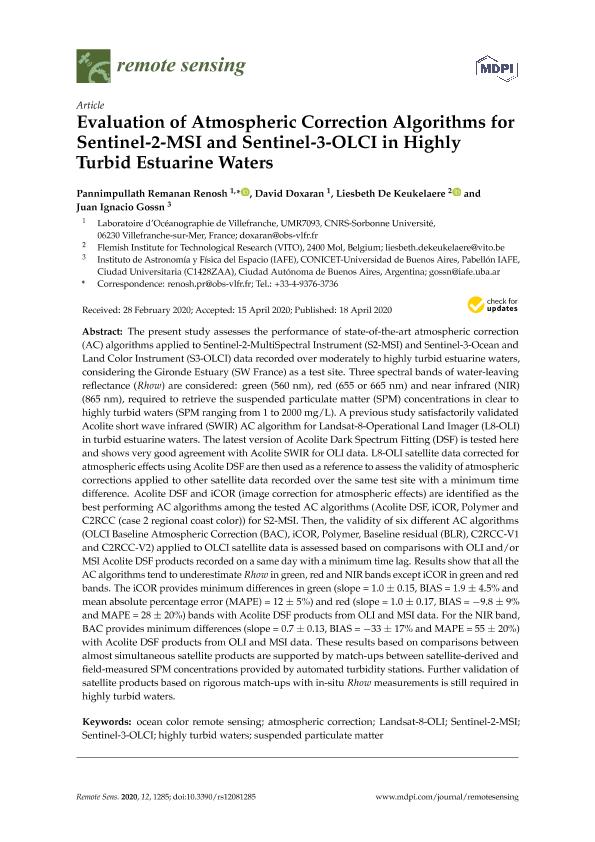Mostrar el registro sencillo del ítem
dc.contributor.author
Renosh, Pannimpullath Remanan
dc.contributor.author
Doxaran, David

dc.contributor.author
Keukelaere, Liesbeth De
dc.contributor.author
Gossn, Juan Ignacio

dc.date.available
2022-04-05T18:47:03Z
dc.date.issued
2020-04
dc.identifier.citation
Renosh, Pannimpullath Remanan; Doxaran, David; Keukelaere, Liesbeth De; Gossn, Juan Ignacio; Evaluation of Atmospheric Correction Algorithms for Sentinel-2-MSI and Sentinel-3-OLCI in Highly Turbid Estuarine Waters; Multidisciplinary Digital Publishing Institute; Remote Sensing; 12; 8; 4-2020; 1-26
dc.identifier.uri
http://hdl.handle.net/11336/154418
dc.description.abstract
The present study assesses the performance of state-of-the-art atmospheric correction (AC) algorithms applied to Sentinel-2-MultiSpectral Instrument (S2-MSI) and Sentinel-3-Ocean and Land Color Instrument (S3-OLCI) data recorded over moderately to highly turbid estuarine waters, considering the Gironde Estuary (SW France) as a test site. Three spectral bands of water-leaving reflectance (Rhow) are considered: green (560 nm), red (655 or 665 nm) and near infrared (NIR) (865 nm), required to retrieve the suspended particulate matter (SPM) concentrations in clear to highly turbid waters (SPM ranging from 1 to 2000 mg/L). A previous study satisfactorily validated Acolite short wave infrared (SWIR) AC algorithm for Landsat-8-Operational Land Imager (L8-OLI) in turbid estuarine waters. The latest version of Acolite Dark Spectrum Fitting (DSF) is tested here and shows very good agreement with Acolite SWIR for OLI data. L8-OLI satellite data corrected for atmospheric effects using Acolite DSF are then used as a reference to assess the validity of atmospheric corrections applied to other satellite data recorded over the same test site with a minimum time difference. Acolite DSF and iCOR (image correction for atmospheric effects) are identified as the best performing AC algorithms among the tested AC algorithms (Acolite DSF, iCOR, Polymer and C2RCC (case 2 regional coast color)) for S2-MSI. Then, the validity of six different AC algorithms (OLCI Baseline Atmospheric Correction (BAC), iCOR, Polymer, Baseline residual (BLR), C2RCC-V1 and C2RCC-V2) applied to OLCI satellite data is assessed based on comparisons with OLI and/or MSI Acolite DSF products recorded on a same day with a minimum time lag. Results show that all the AC algorithms tend to underestimate Rhow in green, red and NIR bands except iCOR in green and red bands. The iCOR provides minimum differences in green (slope = 1.0 ± 0.15, BIAS = 1.9 ± 4.5% and mean absolute percentage error (MAPE) = 12 ± 5%) and red (slope = 1.0 ± 0.17, BIAS = −9.8 ± 9% and MAPE = 28 ± 20%) bands with Acolite DSF products from OLI and MSI data. For the NIR band, BAC provides minimum differences (slope = 0.7 ± 0.13, BIAS = −33 ± 17% and MAPE = 55 ± 20%) with Acolite DSF products from OLI and MSI data. These results based on comparisons between almost simultaneous satellite products are supported by match-ups between satellite-derived and field-measured SPM concentrations provided by automated turbidity stations. Further validation of satellite products based on rigorous match-ups with in-situ Rhow measurements is still required in highly turbid waters.
dc.format
application/pdf
dc.language.iso
eng
dc.publisher
Multidisciplinary Digital Publishing Institute
dc.rights
info:eu-repo/semantics/openAccess
dc.rights.uri
https://creativecommons.org/licenses/by/2.5/ar/
dc.subject
OCEAN COLOR REMOTE SENSING
dc.subject
ATMOSPHERIC CORRECTION
dc.subject
LANDSAT-8/OLI
dc.subject
SENTINEL-2-MSI
dc.subject
SENTINEL-3-OLCI
dc.subject
HIGHLY TURBID WATERS
dc.subject
SUSPENDED PARTICULATE MATTER
dc.subject.classification
Oceanografía, Hidrología, Recursos Hídricos

dc.subject.classification
Ciencias de la Tierra y relacionadas con el Medio Ambiente

dc.subject.classification
CIENCIAS NATURALES Y EXACTAS

dc.title
Evaluation of Atmospheric Correction Algorithms for Sentinel-2-MSI and Sentinel-3-OLCI in Highly Turbid Estuarine Waters
dc.type
info:eu-repo/semantics/article
dc.type
info:ar-repo/semantics/artículo
dc.type
info:eu-repo/semantics/publishedVersion
dc.date.updated
2021-08-20T19:43:46Z
dc.identifier.eissn
2072-4292
dc.journal.volume
12
dc.journal.number
8
dc.journal.pagination
1-26
dc.journal.pais
Suiza

dc.journal.ciudad
Basilea
dc.description.fil
Fil: Renosh, Pannimpullath Remanan. Sorbonne University; Francia. Centre National de la Recherche Scientifique; Francia
dc.description.fil
Fil: Doxaran, David. Sorbonne University; Francia. Centre National de la Recherche Scientifique; Francia
dc.description.fil
Fil: Keukelaere, Liesbeth De. Flemish Institute For Technological Research; Bélgica
dc.description.fil
Fil: Gossn, Juan Ignacio. Consejo Nacional de Investigaciones Científicas y Técnicas. Oficina de Coordinación Administrativa Ciudad Universitaria. Instituto de Astronomía y Física del Espacio. - Universidad de Buenos Aires. Facultad de Ciencias Exactas y Naturales. Instituto de Astronomía y Física del Espacio; Argentina
dc.journal.title
Remote Sensing
dc.relation.alternativeid
info:eu-repo/semantics/altIdentifier/url/https://www.mdpi.com/2072-4292/12/8/1285
dc.relation.alternativeid
info:eu-repo/semantics/altIdentifier/doi/http://dx.doi.org/10.3390/rs12081285
Archivos asociados
